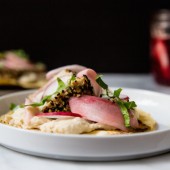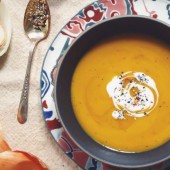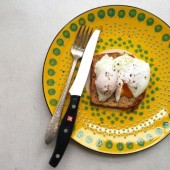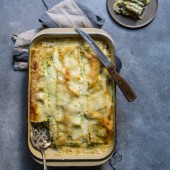Mondays are usually reserved for CSA posts, but out of town last week and with a failed attempt at arranging an alternative pick-up, I was left with no vegetable share.
Which was a blessing in disguise because, especially on weeks that involve travel, my share gives me cold sweats when I get back to a mound of vegetables only to pick up another mound a few days later. So I luxuriated in a week free of obligations, even ordered pepperoni pizza one night, and made the best of it. I was happily reunited with my Week #12 box on Saturday, so friends, you will be seeing a new CSA post in all of its glory up on the site next week.
Until then, let’s talk grains…
One of my first posts on the blog was about sad desk lunches and my efforts to end them. Sadly, I experienced my last desk lunch only weeks after I wrote the post, after deciding that an office environment was no longer for me. Or “happily” I should say, because it was one of the best decisions I’ve ever made. I can’t put a price on the family time I’ve gained, and the happiness I’ve found from building a career on my own terms. That being said, splurging on prescription sunglasses owns a close second place on the best-decisions-list because, well…vision is important too.
One of the best meals to make for portability (aka the desk job) is a grain salad. I make these salads with increasing frequency as the weather starts to chill because they’re a perfect vessel for whatever vegetables that you have on hand – light and summery to use up the last remaining crops from August, or rich and hearty for all of the beautiful squash and root vegetables that are about to hit the markets.
I always feel healthy when I dig into one of these salads. They’re earthy and satisfying without the post-meal sluggishness that comes with eating refined carbs. And what makes them so portable is that you can make them ahead of time – no flimsy lettuce leaves to get bogged down with dressing. Sure, you can make your salad in a jar and just shake at the office, but if you want something even easier, this is the way to go. In fact, I’ve found that grain salads get better when they’re allowed to sit and lounge a little, soaking in the vinaigrette in which they’ve been tossed.
You can make them in the morning, or the evening before, pack them into Tupperware (even better, Wean Green glass food containers that are both shatterproof & beautiful), and head on your merry way. But they’re also great for dinner parties, picnics, and barbeques where you need one or more make-ahead dishes to save your sanity.
I have a standard formula when it comes to making these kinds of salads, which make them endlessly adaptable.
1. Pick your grain
My favorite grain is quinoa because I love that it’s light (as opposed to some of the denser grains), packs a ton of protein, and has a nutty flavor. Plus it’s gluten-free, and while I eat plenty of gluten, it’s nice to take a break from it on occasion.
Other grains that make fabulous salads are Farro, Barley, Bulgur and Wheatberries. There are far more grains from which to choose, but these are the ones that tend to be in my regular rotation.
2. Pick your vegetables
Here, I choose anything that’s in season. In the Fall and Winter it could be some kind of roasted squash. In the spring, it’s often grilled and chopped asparagus. And in the summer, I love to use crunchy vegetables like radishes or lightly-steamed corn.
3. Pick your dressing
I usually choose my dressing flavor after I’ve chosen the vegetables because they’ll influence the style of salad that I’m going for. If I’ve chosen snap peas, radishes, and purple spring onions, I might go for an Asian-style dressing, using toasted sesame oil; if I’ve chosen eggplant or zucchini, I’ll go for a Mediterranean dressing with olive oil and a whole grain mustard. Have fun with your dressings, and doctor them up with herbs or spices. There isn’t a right way or wrong way.
My dressing technique is simple; use 1 part acidic base (favorites are lemon juice, white wine vinegar, and sherry vinegar) with a tablespoon of a thickening condiment to give it body (could be Dijon mustard, whole grain mustard, honey or maple syrup). Whisk together along with some salt & pepper, and while whisking, slowly drizzle in 2 parts olive (or other) oil to emulsify.
Homemade dressing is preferable to jarred versions from the grocery store which I find to be overly sweet, and overly thick. I like my dressings to be lip-smackingly tart, and light enough to coat without weighing my ingredients down. Also, I tend to keep my dressing flavors simple so that the salad ingredients stand out.
4. Pick your fun
In most of my recipes, I try to pick one ingredient that’s a showstopper. Sometimes two. They’re ingredients that either find their way into small local markets, or the farmer’s market. I love to play with microgreens, or ultra seasonal (blink and they’ll miss them) products like ramps and garlic scapes in the Spring, or these incredible Hatch chiles in the late Summer/Fall. They make a dish special, and add a little glamour to your finished product. Cooking is fun when you push yourself out of your comfort zone and incorporate vegetables that you don’t normally eat.
Once I’ve decided on the direction for the salad, and my key ingredients, it’s assembly time. With your prepped and/or cooked ingredients at hand, make your dressing in a large bowl, add your grains and any hearty vegetables (if using) and toss. Then add your delicate vegetables and herbs and give it one last turn in the bowl, making sure to dress all of the ingredients without crushing them.
Serve in a beautiful bowl, and you’ve got simple peasant food fit for royalty. The kind of food that’s perfect for entertaining, and will have your desk mates seething with envy.
Enjoy!
- 2 Tablespoons of white sugar
- 2 Tablespoons of rice vinegar
- ½ cup of water
- 1 small Hatch chile, sliced crosswise into ¼ inch thick rounds (about 1/4 cup)
- ½ teaspoon of yellow mustard seeds
- 1 bay leaf
- 1 Tablespoon of whole grain mustard
- 2 Tablespoons of white wine vinegar
- 6 Tablespoons of olive oil
- Salt and pepper, to taste
- 1 16-oz package of red quinoa, preferably organic, cooked according to package directions
- 4-5 radishes, scrubbed and cut into matchsticks
- 1 large handful of sunflower microgreens
- To quick pickle the Hatch chile
- Bring the sugar, vinegar and water to a boil in a small saucepan.
- While the mixture is heating, place the scape, mustard seeds, and bay leaf into a small (preferably glass) container.
- Once the liquid has come to a boil, pour it over the chiles, and let cool before lidding, and placing in the fridge for a few hours to pickle.
- To make the salad
- In a large bowl, whisk the mustard and vinegar along with the salt and pepper, and while whisking, add the oil in a slow drizzle.
- To your dressing, add your quinoa and give it a toss, coating it in the vinaigrette.
- Next, add your radishes, pickled chiles (drained from pickling juice), and half of your sunflower microgreens. Toss again, and season to taste.
- Top your salad with the remaining sunflower microgreens and serve.
- This salad will keep unrefrigerated for a few hours, making it ideal for picnics; It also keeps well in the fridge and should be used within 2 days.
Please note: I was not compensated to promote Wean Green, although I have received free Wean Green glassware to review. While I regularly receive products to review, only those which I have used and enjoyed using are mentioned on the blog.









Love this post. I adore grain salads. Will definitely make this. Thanks for the dressing tips.
Great tips as always and great ideas! Thx Jess!
What a wonderful healthy salad!!
I love quinoa too! These all sound like wonderful ideas for a salad. I might have to try your recipe too. Thanks for sharing this! Have a terrific day.
Totally agree with you, grain salads are very satisfying and at the same time delicious! I like your suggestions about using root vegetables too… thinking of a pumpkin quinoa salad right now!… 🙂
Great salad and what a beautiful picture! I know what you mean about the sad desk lunches, as much effort as I put, it still happens occasionally unfortunately. I guess the only solution is to change the work environment! 🙂
I love having good grain salads on hand for quick and easy lunches!! The chili aspect to this sounds totally fabulous.